|
|

Chiang Kaishek and Chinese officers at Lushan, Jiujiang, Jiangxi Province, China, 1932.

Kaishek Chiang. 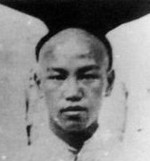
Portrait of Chiang Kaishek at Baoding Military Academy, Hebei, China, 1907.
蔣介石先生傳記,英語版本,敬請各位讀者評審.謝謝.
評論必須有所依據,所附文件資料,檔案,照片,影音訊息,以供考證謝謝.
| Born |
31 Oct 1887. |
| Died |
5 Apr 1975 |
| Country |
China |
|
|
| Gender |
Male |
The romanization of Chiang Kaishek's name was an interesting study. Born at a time when the Wade-Giles method of romanization was more common, his family name was romanized from Mandarin as "Chiang". His given name, however, was romanized from Cantonese as "Kaishek". The mix-use of dialect and romanization methods was rare, but perhaps understandable from a time period when westerners, generally speaking, knew relatively little of Asian cultures.
Kaishek Chiang Timeline
| 31 Oct 1887 |
Chiang Kaishek was born in Fenghua, Zhejiang Province, Qing Dynasty China. |
| 20 Mar 1926 |
Having discovered a Communist plot to kidnap him in Guangzhou in southern China, Chiang Kaishek issued the order to arrest top Communist and left-wing leaders. As Wang Jingwei fled to Paris, France and Zhou Enlai fled to Shanghai, China, Chiang would effectively emerge from this failed plot as the sole leader of the Nationalist Party and its military forces. |
| 5 Apr 1927 |
Chiang Kaishek declared martial law in Shanghai, China as the first step of a bloody purge against Communists. |
| 10 Nov 1927 |
Chiang Kaishek arrived in Shanghai, China from Japan. |
| 1 Dec 1927 |
Chiang Kaishek married Song Meiling. |
| 10 Dec 1927 |
Chiang Kaishek was elected back into power. |
| 9 May 1936 |
Chiang Kaishek proclaimed that Japan was waging war in China without a declaration of war. |
| 26 Dec 1936 |
Chiang Kiashek traveled from Xi'an to Nanjing in China. |
| 12 Aug 1937 |
The Chinese government gave Chiang Kaishek special powers for the duration of the war. |
| 15 Aug 1937 |
Chiang Kaishek officially assumed the role of the commander-in-chief of the Chinese military for the duration of the Second Sino-Japanese War and issued orders to reorganize Chinese Communist forces under Nationalist command. |
| 23 Sep 1937 |
Chiang Kaishek officially announced a united front between Nationalist Party and Communist Party forces against Japan. |
| 7 Dec 1937 |
Chinese President Chiang Kaishek departed Nanjing, China by plane. The civilian administration of the city was left to an International Committee led by John Rabe. Outside the city, several villages were set ablaze by Chinese troops to prevent them from being used by the approaching Japanese troops. |
| 24 Mar 1938 |
Chiang Kaishek inspected troops at Xuzhou, Jiangsu Province, China. He personally appointed Bai Zongxi and Lin Weizu as staff officers of the 5th War Area. |
| 19 Dec 1941 |
In India, General Wavell received a telegram from Chiang Kaishek in which the Generalissimo offered to join any plan proposed by the Allies. |
| 31 Dec 1941 |
Franklin Roosevelt notified Chiang Kaishek that he had obtained agreement from the governments of Britain, Australia, New Zealand and the Netherlands for the establishment of a China Theatre of War with the Generalissimo as the Supreme Allied Commander. |
| 19 Jan 1942 |
US Secretary of War Henry Stimson formally asked Chiang Kaishek to approve a US commander for Chinese troops fighting in Burma; Chiang agreed, albeit with ambiguous language. |
| 11 Mar 1942 |
Chiang Kaishek told Joseph Stilwell that he was now ready to commit three elite Chinese armies (5th, 6th, and 66th) to Burma. Stilwell would soon find out that Chiang had secretly ordered the Chinese commanders to avoid decisive confrontations, thus rendering the Chinese troops useless to Stilwell's command. |
| 1 Jul 1942 |
Chiang Kaishek formally submitted his "Three Demands" to Joseph Stilwell to forward on to Washington DC, United States. This request included 5,000 tons of supplies, 500 war planes, and 3 US divisions for the Chinese theater of war. US President Franklin Roosevelt would superficially agree to the demands, but would stall the delivery indefinitely. |
| 1 Aug 1942 |
Chiang Kaishek accepted Joseph Stilwell's X-Y Plan for an offensive into Burma on the conditions that British generals fully cooperate with the campaign and that the Allies would support the offensive from the air. |
| 14 Oct 1942 |
Chiang Kaishek agreed to fully commit to a campaign in Burma if the United Kingdom did the same and that the Allies had naval and air superiority in the Bay of Bengal. |
| 3 Nov 1942 |
Chiang Kaishek met with Joseph Stilwell regarding the planned offensive into Burma, pledging 15 divisions by 15 Feb 1943. |
| 28 Dec 1942 |
Chiang Kaishek cabled Washington DC in the United States, complaining of Archibald Wavell's uncooperativeness regarding a possible coordinated offensive in Burma. |
| 7 Feb 1943 |
Chiang Kaishek messaged Franklin Roosevelt, agreeing with Chinese support for an offensive into Burma. |
| 7 Jul 1943 |
Joseph Stilwell presented Chiang Kaishek and He Yingqin the Legion of Merit medals. |
| 12 Jul 1943 |
Chiang Kaishek committed, in writing, to a Chinese offensive into Burma. |
| 13 Sep 1943 |
Chiang Kaishek reluctantly agreed to stop the fighting against communist forces in China and turn his full attention to the Japanese. |
| 12 Nov 1943 |
Patrick Hurley met with Chiang Kaishek. |
| 27 Nov 1943 |
Chiang Kaishek asked Joseph Stilwell to secure 10,000 tons of supplies to be flown over the Hump into China per month, while China would not make commitment on any American demands. |
| 7 Sep 1944 |
Chiang Kaishek met with Joseph Stilwell, Patrick Hurley, and Donald Nelson in Chongqing, China. |
| 23 Feb 1945 |
Chiang Kaishek unexpectedly withdrew all Chinese forces from Burma. |
| 6 Jun 1946 |
Fearing the United States would scale back aid if he did not comply, Chiang Kaishek accepted George Marshall's request for the Nationalists to halt their so far successful offensive against the Chinese Communists in northeastern China by announcing a 15-day truce. In the mean time, Marshall would naively attempt to engage with the Communists in peace negotiations. |
| 5 Apr 1975 |
Having suffered a major heart attack and pneumonia in the previous few months, Chiang Kaishek passed away from kidnay failure and advanced cardiac malfunction at 2350 hours in Taipei, Taiwan, Republic of China. A month of mourning was declared. |

Portrait of Chiang Kaishek, as a cadet at a Japanese military academy, with friends, 1907.
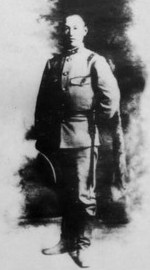
Portrait of Chiang Kaishek as a Japanese Army enlisted man, 1911.
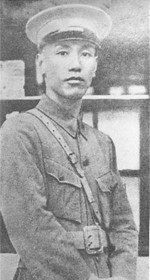 Chiang Kaishek, date unknown Chiang Kaishek, date unknown
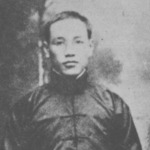 Portrait of Chiang Kaishek, circa early 1920s Portrait of Chiang Kaishek, circa early 1920s
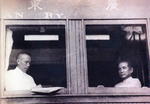 |
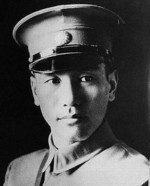 |
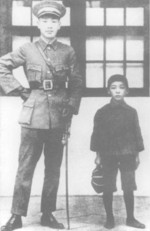 |
| Portrait of Chiang Kaishek, circa early 1920s |
Chiang Kaishek and Sun Yatsen, 1923 |
|
Chiang Kaishek with his son Chiang Wei-kuo, 1924 |
|